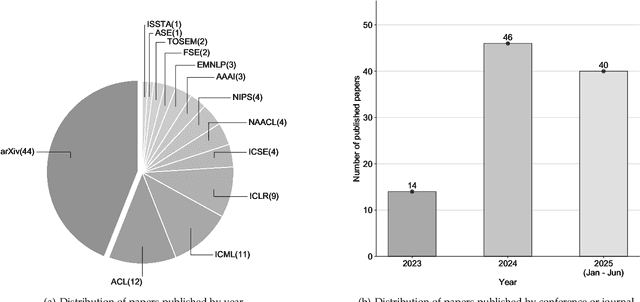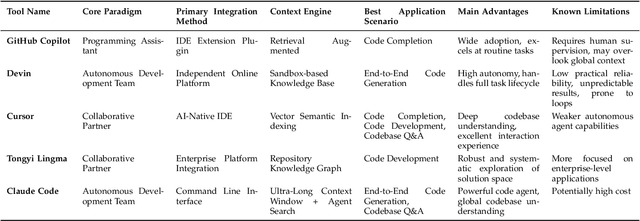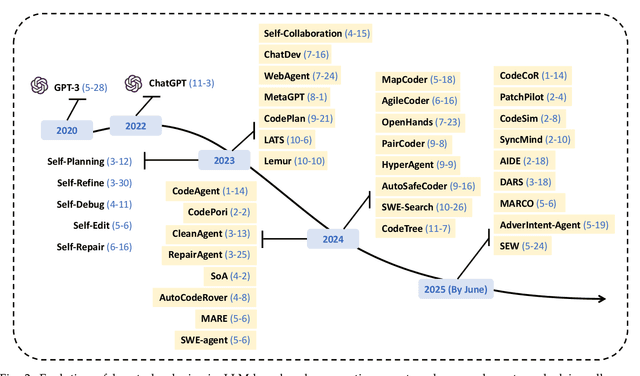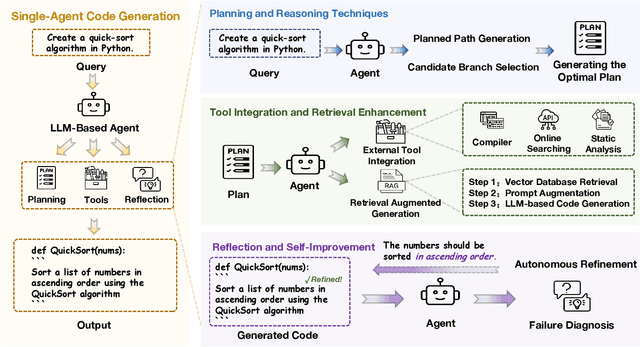Yihong Dong
EvoCoT: Overcoming the Exploration Bottleneck in Reinforcement Learning
Aug 11, 2025Abstract:Reinforcement learning with verifiable reward (RLVR) has become a promising paradigm for post-training large language models (LLMs) to improve their reasoning capability. However, when the rollout accuracy is low on hard problems, the reward becomes sparse, limiting learning efficiency and causing exploration bottlenecks. Existing approaches either rely on stronger LLMs for distillation or filter out difficult problems, which limits scalability or restricts reasoning improvement through exploration. We propose EvoCoT, a self-evolving curriculum learning framework based on two-stage chain-of-thought (CoT) reasoning optimization. EvoCoT constrains the exploration space by self-generating and verifying CoT trajectories, then gradually shortens them to expand the space in a controlled way. This enables LLMs to stably learn from initially unsolved hard problems under sparse rewards. We apply EvoCoT to multiple LLM families, including Qwen, DeepSeek, and Llama. Experiments show that EvoCoT enables LLMs to solve previously unsolved problems, improves reasoning capability without external CoT supervision, and is compatible with various RL fine-tuning methods. We release the source code to support future research.
A Survey on Code Generation with LLM-based Agents
Jul 31, 2025



Abstract:Code generation agents powered by large language models (LLMs) are revolutionizing the software development paradigm. Distinct from previous code generation techniques, code generation agents are characterized by three core features. 1) Autonomy: the ability to independently manage the entire workflow, from task decomposition to coding and debugging. 2) Expanded task scope: capabilities that extend beyond generating code snippets to encompass the full software development lifecycle (SDLC). 3) Enhancement of engineering practicality: a shift in research emphasis from algorithmic innovation toward practical engineering challenges, such as system reliability, process management, and tool integration. This domain has recently witnessed rapid development and an explosion in research, demonstrating significant application potential. This paper presents a systematic survey of the field of LLM-based code generation agents. We trace the technology's developmental trajectory from its inception and systematically categorize its core techniques, including both single-agent and multi-agent architectures. Furthermore, this survey details the applications of LLM-based agents across the full SDLC, summarizes mainstream evaluation benchmarks and metrics, and catalogs representative tools. Finally, by analyzing the primary challenges, we identify and propose several foundational, long-term research directions for the future work of the field.
RL-PLUS: Countering Capability Boundary Collapse of LLMs in Reinforcement Learning with Hybrid-policy Optimization
Jul 31, 2025Abstract:Reinforcement Learning with Verifiable Reward (RLVR) has significantly advanced the complex reasoning abilities of Large Language Models (LLMs). However, it struggles to break through the inherent capability boundaries of the base LLM, due to its inherently on-policy strategy with LLM's immense action space and sparse reward. Further, RLVR can lead to the capability boundary collapse, narrowing the LLM's problem-solving scope. To address this problem, we propose RL-PLUS, a novel approach that synergizes internal exploitation (i.e., Thinking) with external data (i.e., Learning) to achieve stronger reasoning capabilities and surpass the boundaries of base models. RL-PLUS integrates two core components: Multiple Importance Sampling to address for distributional mismatch from external data, and an Exploration-Based Advantage Function to guide the model towards high-value, unexplored reasoning paths. We provide both theoretical analysis and extensive experiments to demonstrate the superiority and generalizability of our approach. The results show that RL-PLUS achieves state-of-the-art performance compared with existing RLVR methods on six math reasoning benchmarks and exhibits superior performance on six out-of-distribution reasoning tasks. It also achieves consistent and significant gains across diverse model families, with average relative improvements ranging from 21.1\% to 69.2\%. Moreover, Pass@k curves across multiple benchmarks indicate that RL-PLUS effectively resolves the capability boundary collapse problem.
SATURN: SAT-based Reinforcement Learning to Unleash Language Model Reasoning
May 22, 2025Abstract:How to design reinforcement learning (RL) tasks that effectively unleash the reasoning capability of large language models (LLMs) remains an open question. Existing RL tasks (e.g., math, programming, and constructing reasoning tasks) suffer from three key limitations: (1) Scalability. They rely heavily on human annotation or expensive LLM synthesis to generate sufficient training data. (2) Verifiability. LLMs' outputs are hard to verify automatically and reliably. (3) Controllable Difficulty. Most tasks lack fine-grained difficulty control, making it hard to train LLMs to develop reasoning ability from easy to hard. To address these limitations, we propose Saturn, a SAT-based RL framework that uses Boolean Satisfiability (SAT) problems to train and evaluate LLM reasoning. Saturn enables scalable task construction, rule-based verification, and precise difficulty control. Saturn designs a curriculum learning pipeline that continuously improves LLMs' reasoning capability by constructing SAT tasks of increasing difficulty and training LLMs from easy to hard. To ensure stable training, we design a principled mechanism to control difficulty transitions. We introduce Saturn-2.6k, a dataset of 2,660 SAT problems with varying difficulty. It supports the evaluation of how LLM reasoning changes with problem difficulty. We apply Saturn to DeepSeek-R1-Distill-Qwen and obtain Saturn-1.5B and Saturn-7B. We achieve several notable results: (1) On SAT problems, Saturn-1.5B and Saturn-7B achieve average pass@3 improvements of +14.0 and +28.1, respectively. (2) On math and programming tasks, Saturn-1.5B and Saturn-7B improve average scores by +4.9 and +1.8 on benchmarks (e.g., AIME, LiveCodeBench). (3) Compared to the state-of-the-art (SOTA) approach in constructing RL tasks, Saturn achieves further improvements of +8.8%. We release the source code, data, and models to support future research.
Rethinking Repetition Problems of LLMs in Code Generation
May 15, 2025Abstract:With the advent of neural language models, the performance of code generation has been significantly boosted. However, the problem of repetitions during the generation process continues to linger. Previous work has primarily focused on content repetition, which is merely a fraction of the broader repetition problem in code generation. A more prevalent and challenging problem is structural repetition. In structural repetition, the repeated code appears in various patterns but possesses a fixed structure, which can be inherently reflected in grammar. In this paper, we formally define structural repetition and propose an efficient decoding approach called RPG, which stands for Repetition Penalization based on Grammar, to alleviate the repetition problems in code generation for LLMs. Specifically, RPG first leverages grammar rules to identify repetition problems during code generation, and then strategically decays the likelihood of critical tokens that contribute to repetitions, thereby mitigating them in code generation. To facilitate this study, we construct a new dataset CodeRepetEval to comprehensively evaluate approaches for mitigating the repetition problems in code generation. Extensive experimental results demonstrate that RPG substantially outperforms the best-performing baselines on CodeRepetEval dataset as well as HumanEval and MBPP benchmarks, effectively reducing repetitions and enhancing the quality of generated code.
Thinking Longer, Not Larger: Enhancing Software Engineering Agents via Scaling Test-Time Compute
Mar 31, 2025Abstract:Recent advancements in software engineering agents have demonstrated promising capabilities in automating program improvements. However, their reliance on closed-source or resource-intensive models introduces significant deployment challenges in private environments, prompting a critical question: \textit{How can personally deployable open-source LLMs achieve comparable code reasoning performance?} To this end, we propose a unified Test-Time Compute scaling framework that leverages increased inference-time computation instead of larger models. Our framework incorporates two complementary strategies: internal TTC and external TTC. Internally, we introduce a \textit{development-contextualized trajectory synthesis} method leveraging real-world software repositories to bootstrap multi-stage reasoning processes, such as fault localization and patch generation. We further enhance trajectory quality through rejection sampling, rigorously evaluating trajectories along accuracy and complexity. Externally, we propose a novel \textit{development-process-based search} strategy guided by reward models and execution verification. This approach enables targeted computational allocation at critical development decision points, overcoming limitations of existing "end-point only" verification methods. Evaluations on SWE-bench Verified demonstrate our \textbf{32B model achieves a 46\% issue resolution rate}, surpassing significantly larger models such as DeepSeek R1 671B and OpenAI o1. Additionally, we provide the empirical validation of the test-time scaling phenomenon within SWE agents, revealing that \textbf{models dynamically allocate more tokens to increasingly challenging problems}, effectively enhancing reasoning capabilities. We publicly release all training data, models, and code to facilitate future research. https://github.com/yingweima2022/SWE-Reasoner
FANformer: Improving Large Language Models Through Effective Periodicity Modeling
Feb 28, 2025Abstract:Periodicity, as one of the most important basic characteristics, lays the foundation for facilitating structured knowledge acquisition and systematic cognitive processes within human learning paradigms. However, the potential flaws of periodicity modeling in Transformer affect the learning efficiency and establishment of underlying principles from data for large language models (LLMs) built upon it. In this paper, we demonstrate that integrating effective periodicity modeling can improve the learning efficiency and performance of LLMs. We introduce FANformer, which integrates Fourier Analysis Network (FAN) into attention mechanism to achieve efficient periodicity modeling, by modifying the feature projection process of attention mechanism. Extensive experimental results on language modeling show that FANformer consistently outperforms Transformer when scaling up model size and training tokens, underscoring its superior learning efficiency. To further validate the effectiveness of FANformer, we pretrain a FANformer-1B on 1 trillion tokens. FANformer-1B exhibits marked improvements on downstream tasks compared to open-source LLMs with similar model parameters or training tokens. The results position FANformer as an effective and promising architecture for advancing LLMs.
Why language models collapse when trained on recursively generated text
Dec 19, 2024



Abstract:Language models (LMs) have been widely used to generate text on the Internet. The generated text is often collected into the training corpus of the next generations of LMs. Previous work has experimentally found that LMs collapse when trained on recursively generated text. This paper contributes to existing knowledge from two aspects. We present a theoretical proof of LM collapse. Our proof reveals the cause of LM collapse and proves that all auto-regressive LMs will definitely collapse. We present a new finding: the performance of LMs gradually declines when trained on recursively generated text until they perform no better than a randomly initialized LM. The trained LMs produce large amounts of repetitive text and perform poorly across a wide range of natural language tasks. The above proof and new findings deepen our understanding of LM collapse and offer valuable insights that may inspire new training techniques to mitigate this threat.
BANER: Boundary-Aware LLMs for Few-Shot Named Entity Recognition
Dec 03, 2024



Abstract:Despite the recent success of two-stage prototypical networks in few-shot named entity recognition (NER), challenges such as over/under-detected false spans in the span detection stage and unaligned entity prototypes in the type classification stage persist. Additionally, LLMs have not proven to be effective few-shot information extractors in general. In this paper, we propose an approach called Boundary-Aware LLMs for Few-Shot Named Entity Recognition to address these issues. We introduce a boundary-aware contrastive learning strategy to enhance the LLM's ability to perceive entity boundaries for generalized entity spans. Additionally, we utilize LoRAHub to align information from the target domain to the source domain, thereby enhancing adaptive cross-domain classification capabilities. Extensive experiments across various benchmarks demonstrate that our framework outperforms prior methods, validating its effectiveness. In particular, the proposed strategies demonstrate effectiveness across a range of LLM architectures. The code and data are released on https://github.com/UESTC-GQJ/BANER.
FAN: Fourier Analysis Networks
Oct 03, 2024



Abstract:Despite the remarkable success achieved by neural networks, particularly those represented by MLP and Transformer, we reveal that they exhibit potential flaws in the modeling and reasoning of periodicity, i.e., they tend to memorize the periodic data rather than genuinely understanding the underlying principles of periodicity. However, periodicity is a crucial trait in various forms of reasoning and generalization, underpinning predictability across natural and engineered systems through recurring patterns in observations. In this paper, we propose FAN, a novel network architecture based on Fourier Analysis, which empowers the ability to efficiently model and reason about periodic phenomena. By introducing Fourier Series, the periodicity is naturally integrated into the structure and computational processes of the neural network, thus achieving a more accurate expression and prediction of periodic patterns. As a promising substitute to multi-layer perceptron (MLP), FAN can seamlessly replace MLP in various models with fewer parameters and FLOPs. Through extensive experiments, we demonstrate the effectiveness of FAN in modeling and reasoning about periodic functions, and the superiority and generalizability of FAN across a range of real-world tasks, including symbolic formula representation, time series forecasting, and language modeling.
 Add to Chrome
Add to Chrome Add to Firefox
Add to Firefox Add to Edge
Add to Edge